2006 Innovators
 A HISTORY TEACHER uses a computer game to interest students in WorldWar II. A former TV reporter creates a new journalism curriculum that turnshigh school kids into real on-air broadcasters. An administrator and a technologycoordinator team up to bring their campuses in contact with othersaround the world. A project director devises a vocational IT training programfor high schoolers. An ESL teacher boosts English literacy by getting freecomputers and DSL service into the homes of immigrant students.
A HISTORY TEACHER uses a computer game to interest students in WorldWar II. A former TV reporter creates a new journalism curriculum that turnshigh school kids into real on-air broadcasters. An administrator and a technologycoordinator team up to bring their campuses in contact with othersaround the world. A project director devises a vocational IT training programfor high schoolers. An ESL teacher boosts English literacy by getting freecomputers and DSL service into the homes of immigrant students.
What thread links all of these educators? They are difference makers, and in the past year they have demonstrated the power of educational technology to transform teaching and learning. For their achievements, they are among a select group, chosen by our panel from roughly 200 nominees: T.H.E. Journal’s 2006 Innovators.
:: MAKING A GAME OF IT
 Innovator: David McDivitt, Oak Hill High School (IN)
Innovator: David McDivitt, Oak Hill High School (IN)
Breakthrough: Educational gaming
In his 13th year teaching at Oak Hill High School, David McDivitt is always searching for ways to motivate and engage his students. With increasing access to technological devices and the explosion of gaming within the student culture, it was only natural that McDivitt, an avid gamer himself, turned to computergames to reach students with something they love.
The program began last spring, when during a unit about the political and economic causes of World War II, McDivitt introduced students to an off-the-shelf computer game called Making History. The game, from manufacturer Muzzy Lane, has players reenact different phases of the war and strategize to determine outcomes in a virtual space.
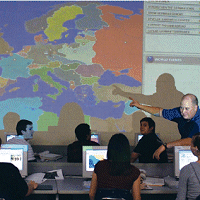
ON POINT Making History can create historically
inaccurate results, so McDivitt continues instructing
his students while they play the game.
While the game is fun, McDivitt chose it because of its emphasis on history. He also selected Making History because it passes what he calls the “mommy test.” There is no blood or gore, no foul language. There is no lewd or inappropriate content of any kind. Also, because Making History was designed in such a way that it does not take 20 hours of play to reach the final phase, McDivitt was able to use the game without taking up too much class time.
In all, 64 sophomore students learned about the early stages of World War II by playing Making History. As a control, McDivitt taught another group of students with standard history textbooks and conventional lectures and assignments. When he tested both groups of students, those who had learned via the game scored as well or better on every single question. In particular, game players were noticeably better at identifying the geography of Europe, explaining the significance of the 1938 Munich Conference, and listing reasons for the start of the war.
With results like these, McDivitt has turned to other games to enhance the learning process. This year, in his sociology class, he started using Electronic Arts’ The Sims 2, which enlists students in directing the lives of simulated people. It’s filled with social interaction and relationships, and puts many things from the textbook into the context of a game. He also has introduced blogging to his sociology students, who are instructed to make their blogs school-appropriate. Most of their writings relate to The Sims.
McDivitt says he is surprised by how much his students have enjoyed blogging; it is just a form of journaling in a public forum. Still, he knows that games and other new forms of social networking can never completely replace age-old instructional methods, or the importance of the physical presence of the teacher. But he says technology can be a potent complement.
“Anytime I can use technology in class, it helps me connect with kids who are walking around with cell phones, iPods, laptop computers,” he says. “Instead of fighting the technology that everyone’s exposed to, we need to embrace it. We can use it in the educational world to teach kids.”
:: THE POD SQUAD
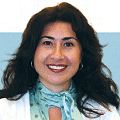 Innovator: Grace Poli, José Martí Middle School (NJ)
Innovator: Grace Poli, José Martí Middle School (NJ)
Breakthrough: English proficiency
In 2004, Grace Poli, media specialist for José Martí Middle School in Union City, NJ, began developing a program to help her school’s bilingual students become proficient in English using an iPod as the primary classroom learning tool.
“When I first looked at the iPod, I quickly realized that this is much more than a device for listening to music,” says Poli, whose district uses Apple laptops, iMac desktops, and Apple mobile carts in most areas of its curriculum. “And, in fact, it can be a very powerful educational tool, especially for our limited-English-proficient students.”
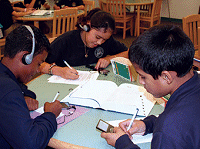
AN APPLE FOR THE STUDENTS At José
Martí Middle School, ESL kids use an iPod as
their primary tool for gaining proficiency in English.
Pod People, as the program is known, helps the school’s ESL students learn English by engaging them in a new and exciting way. The three main teaching components of the program are audio books, for reading comprehension; song lyrics, for teaching proper grammar; and the iPod voice recorder, for improving speaking skills.
Pod People started as a special seed-grant program for technology innovation, sponsored by the superintendent of schools. Therefore, initially it had to be small in scale and economically feasible, and it had to deliver noticeable, measurable results—and it did. “My biggest surprise was that, within just the first year, half of the Pod People students successfully exited the bilingual program, having become proficient in English,” says Poli. “Now these very same students are in regular classes, receiving instruction in English. And two of these students recently graduated with honors.”
The program has proven so successful that it is being expanded this year to 12 other schools in the largely Hispanic Union City School District as part of a pilot project, and now at José Martí, it’s being used to teach students with special needs. Rather than audio books and song lyrics, teachers are using podcasting as the principal teaching and learning tool. The students are using Apple’s GarageBand to create instructional podcasts to help them review for the New Jersey Grade Eight Proficiency Assessment. They are also using the iPods to write stories that will be turned into podcasts.
From her experiences developing the Pod People program, Poli says the best advice is to “always consider all types of technology as a potential learning tool for the classroom. We discovered that, through the implementation of iPod technology, the Pod People lessons greatly enhanced the learning experience, yielding extremely positive benefits for our students, a renewed enthusiasmfrom their parents, and inspiration for their teachers.”
:: A PORTAL TO THE 21st CENTURY
Innovator: Patricia Carlson, Rose-Hulman Institute of Technology (IN)
Breakthrough: Online resources for educators

POWER SOURCE Carlson says
PRISM buoys Indiana’s STEM teachers.
Educators can find a wealth of online resources that improve student learning and enhance motivation. One such resource is a free, web-based hub called Portal Resources for Indiana Science and Mathematics (PRISM), which helps middle school science, technology, engineering, and math (STEM) teachers in Indiana find interactive, standards-indexed, peer-reviewed instructional resources. Developed by the Rose- Hulman Institute of Technology with financial support from the Lilly Endowment, a private philanthropic foundation, PRISM addresses two critical issues for 21st-century STEM teaching, according to Patricia Carlson,director of the project:
- The ever-widening gap between the production of quality, web-delivered instructional new media and the ability of middle school teachers to integrate these advancements into their classrooms.
- The demands placed on teachers by new reform guidelines— both state and national—that call for less dependence on textbooks, lectures, and decontextualized lab work, and greater emphasis on inquiry-based learning containing real-world contexts that use science and mathematics to solve a humanproblem, meet a societal need, or develop a product.
PRISM’s flagship component is a digital library boasting a collection of more than 2,300 web-delivered resources indexed to the sixth- through eighth-grade Indiana Academic Standards and cross-referenced by learning concept. Each resource is reviewed by a teacher in the field, using uniform standards. Over the years, the system has added materials based on the feedback received from classroom teachers. Additionally, the PRISM webmaster ensures that all informationis current and all links unbroken.
PRISM’s newest service is a free eLearning platform powered by Moodle, an open-source product that requires no licensing fee and offers a variety of stimulating learning tools. By integrating Moodle, PRISM is able to provide its users with most of the features and functionality of other similar commercial products, such as Blackboard and WebCT (which has merged with Blackboard).
Using Moodle, PRISM allows teachers to post interactive assignments, surveys, and quizzes; accept student assignments electronically; conduct class polling; and maintain online grading and class rosters. A robust rich-text editor that handles mathematical formulas and scientific notations also allows teachers to create engaging class work and web pages. Registered members of PRISM can set up a lesson, or an entire course, by creating or importing content, establishing a roster of students, sequencing activities (including online quizzes and other forms of assessment), and enabling a peer-review feature so that students can electronically critique each other’s work. Teachers can also create virtual student teams that can work together outside the classroom.
“PRISM has become the premier website for Indiana teachers of sixth- to eighth-grade STEM,” says Carlson. “And although PRISM was designed for classroom teachers, we have been surprised by the number of home-schooling parents whoare making use of our resources.”
:: BUILDING A BETTER CLASSROOM
Innovator: Terry Wynn, Elkhart Unified School District 218 (KS)
Breakthrough: Technology-integrated instruction
At Elkhart Unified School District 218 in Kansas, educators’ efforts to incorporate technology into their students’ education has led to the creation of a new program called Technology Rich Classrooms (TRCs). The classrooms were developed last year in an effort to enhance student abilities in reading, math, and science. Another goal was for teachers to improve their own technology skills and use those improved skills to integratetechnology into other lessons.
The technology at work in these TRCs includes Apple PowerBook G4 laptops with wireless cards, TeamBoard interactive whiteboards and tablets, NEC VT670 media projectors, Microsoft Office software, and Marratech videoconferencing software and equipment.
Another beneficiary of all the new technology is the district’s 21st Century Afterschool Program. This initiative, launched in 2000, provides supervised time after school for students to study, do homework, and read. It’s geared toward students up to thesixth grade and is available every day from 3:15 p.m. to 6 p.m.
Elkhart has also advanced technology use outside the classroom. One example: Middle and high school students have taken over the local cable channel as a means to inform the community about events going on in the district. This project has enabled students to share resources with others throughout the state.
All of these innovations have benefited teachers as much as students. The TRC program provides a hired facilitator to train Elkhart teachers, and the goal is to make use of social and instructional techniques that will positively impact academic achievement and ultimately help teachers become better educators. According to Technology Director Terry Wynn, one of the district’s greatest accomplishments is making its teachers aware of the value of differentiated instruction through the varied use of technology.
Wynn says Elkhart will continue to seek out the latest technology and integrate that equipment so it can keep providing students with the means to future success. The district also plans to provide additional funding for the Elkhart Cyber School, an effort begun in 2000 to reach kids who are unable to get to the classroom. ECS was one of the first three online schools in the state of Kansas, and to date has deployed more than 150 computers—free of charge—in student homes.
:: ALL HANDS-ON TECH
 Innovator: Jana Hambruch, Dunbar High School (FL)
Innovator: Jana Hambruch, Dunbar High School (FL)
Breakthrough: IT vocational training
With a $3.3 million Magnet School Assistance Program grant from the US Department of Education, Dunbar High School in southwestern Florida was able to launch the Academy for Technology Excellence, an initiative that provides high-end technology training andexperience to high school students.
Specifically, the ATE program offers students in grades 9 to 12 hands-on instruction from highly qualified, certified instructors. Seniors in the program even get their own computers. All ATE students have the opportunity to acquire up to 13 nationally and internationally recognized IT certifications during their time in high school. The academy also offers honors credit and meets the requirements for the Florida Gold Seal Vocational Scholarship.
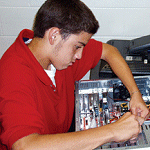
WELL TRAINED Dunbar High’s
ATE program provides students with
professionally recognized IT certifications.
The program was the brainchild of Jana Hambruch, project director for the Office of Zone and Attractor Programs at Dunbar. Though Hambruch designed the program to mimic the real-world training students would encounter as full-fledged IT professionals, the academy works just like any other school. There are classes. The classes are taught by teachers. The teachers give homework.
What’s different about the ATE’s curriculum is the learning environment. Departing from the typical chalkboard-oriented classroom, students learn in laboratory facilities that have been completely renovated and outfitted with such devices as LCD projectors, Smart Technologies Smart Boards, custom computer desks, ergonomic chairs, high-end computers with removable hard drives, and LCD flat-screen monitors. The academy also is implementing cutting-edge technologies, including VMware virtualization technology and Dell PowerEdge servers.
Last year, 100 students enrolled in the program, and 59 of them earned at least one IT certification. Of those 59, 30 students earned two or more certifications. The school’s most prolific student, junior Sam Williams, was able to earn six technology certifications in one year.
By the end of the year, Dunbar students were asked to participate in a joint venture with LearnTV, a student-operated educational TV station in Lancaster, SC, through which the students shared their expertise in a series of television programs about technology.
The ATE continues to grow. Current enrollment is approximately 125 students. Hambruch says the school’s ultimate goal is to enroll a maximum of 360 students and to offer a waiting list for others who want to attend.
The ATE’s grant runs out at the end of next July. Hambruch says she will focus her efforts on sustaining the program without the aid of federal funds. Possibilities include donations from individuals or organizations, and sponsorships from some of the corporations already supporting the school: Cisco Systems, Gateway,Microsoft, and the Computing Technology Industry Association.
:: STUDENTS CONNECTING STUDENTS
Innovator: Dru Urquhart, Spruce Creek High School (FL)
Breakthrough: School management system
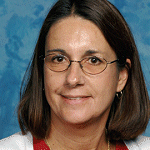
DRU’S CREW Urquhart’s students
helped her develop CreekConnect.
During the summer of 2002, Dru Urquhart, computer programming teacher for Spruce Creek High School in Port Orange, FL, set out to build an online gradebook program that would relieve teachers of excessive paperwork and recordkeeping. It was a big job, so she enlisted the help of students in the school’s technology club. “If students are allowed to work on a project such as this,” she says, “the pride and ownershipis authentic and life-enriching.”
It took about a year to write the initial software, build and set up web and database servers, and carefully choose a secure method of encryption and account access. But by the time CreekConnect was introduced schoolwide in August 2003, it had evolved into a total school managementsystem.
“Writing software is an enormous undertaking, yet the rewards are great,” Urquhart says. “The program has helped somany teachers, students, and parents communicate.”
What makes CreekConnect so special? First, when parents and students open accounts, they are the only ones who can see the individual student records. An e-mail component of the system permits parents, teachers, and students to communicate with each other through comments and questions. Another featureenables students to find theirgrade point averages. For anyclass, a student can enter a grade,then the system recalculates,showing that grade’s impact onthe GPA. Most impressive, all ofthis information can also beaccessed by a cell phone.
“This is a win-win situation for our students and our school,” Urquhart says. “Our students are learning and applying high-end programming and database skills while developing a cost-free program that can be used by our entire school.”
There are currently 217 staff and faculty members, 2,683 students, and 1,590 parents using CreekConnect. Teachers use the program for tasks such as inputting grades, creating seating charts, and collecting assignments electronically. Students use CreekConnect as a student planner, to submit assignments, to check grades, and to communicate with teachers. Parents are given the same access as students, with the exception of being unable to submit assignments. The student technology team has also developed a handful of CreekConnect modules for the different departments around campus, including the attendance office, the dean’s office, and the media center. All of these modules work together to assist with management of information throughout the entire school.
The system is maintained by Urquhart and a small group of third- and fourth-year computer programming students, who help write changes and additions to CreekConnect based on community input. “We get ideas almost daily from teachers, students, and parents on how to make the program better,” Urquhart says. “We will just continue to take these ideas and implement the ones that are possible.”
:: KEEPING IT CLEAN
Innovator: Jim Culbert, Duval County Public Schools (FL)
Breakthrough: Content filtering
Kids will be kids, which is why the drive to use technology to block access to internet pornography is so important to protecting the computing environment at Duval County Public Schools in Jacksonville, FL.

ID, PLEASE? To ensure district
computers are not being used to
access pornography, Culbert wants
to implement better forms of authentication.
The effort began last year. After monitoring reports generated by the school’s enterprise reporting system, district CIO Jim Culbert notified Duval County School Board members that students and staff were using school computers to access pornography on the web. Mortified, the board commissioned Culbert to find a content filtering solution to make the network safe again.
Culbert went to work. He surveyed the market for a number of content filtering solutions and learned that because the district has more than 200 remote sites, securing every corner of the network would not be easy. Complicating matters were staff issues: Duval County lacked the information systems personnel to manage more than a handful of content filters. Eventually, the district settled on the R3000 line of products from 8e6 Technologies, which could be managed centrally from the district’s data center.
Immediately, the new filter provided Culbert and other IS officials with a clear picture of the categories and types of content that students and staff were accessing. The data enabled officials to see exactly what content was inappropriate and exactly where that content was coming from. Then, the district created a committee of teachers, parents, administrators, and media specialists to establish which categories of content it would allow students and staff to access.
The next step was to put in place a policy that would deal with anyone who repeatedly and intentionally accessed inappropriate websites. The policy set thresholds that would prompt additional reports to be run. “If somebody has, say, 20 hits in a week in the category of adult pornography,” Culbert says, “that would automatically trigger us to run a report that shows all the activity for that user for the week.”
Ultimately, this effort led to the creation of an acceptable use policy that every district employee was required to acknowledge and electronically agree to before being given access to the network. Students signed a version of the AUP as well, and were required to get parental permission before they were allowed internet access.
Today, every time they log in, users are met with a banner to remind them of the policy. Everything users do on the network is monitored—they are advised to have no expectation of privacy when using district computers or equipment.
Down the road, Culbert says, the goal is to block unauthorized users from getting online, and to identify every user that accesses the internet though better forms of authentication. As Culbert says, a school district can never be too safe.
:: OPERATION: HIGH TECH
 Innovator: Randy Clarkson, Prairiland Independent School District (TX)
Innovator: Randy Clarkson, Prairiland Independent School District (TX)
Breakthrough: Technology literacy
At Prairiland Independent School District in northeast Texas, educators are celebrating a recent push to increase technology literacy among its students and teachers.
The project spans a variety of areas. First, the district installed data projectors in each classroom on its four campuses, as well as electronic whiteboards with video-capture technology. Next, Prairiland implemented dedicated servers from which teachers and students can download PowerPoint presentations, streaming videos, and other academic materials.
For its two new Video Technology Labs, the district purchased Intel-based iMacs loaded with OS X and Windows XP, as well as specialized software including iLife ’06 Suite, Final Cut Pro, and Wire Cast. Students also received iPods to use as digital notebooks.
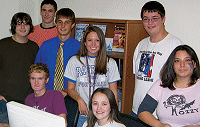
TECHIES Prairiland high school students
in their new Video Technology Lab.
For teacher training, the district chose Atomic Learning, a web-based tutorial for published software, technology techniques, and more. All teachers are required to complete 15 hours of training per semester. The interface allows for self-paced study.
According to Randy Clarkson, the district’s technology training facilitator, the value of the program can be seen in teachers’ improved use of technology, the excitement of the students, and the increased involvement of the community in the use of the available technology resources. Clarkson adds that the district expects to see positive results in the form of higher scores on the Texas Assessment of Knowledge and Skills and the ACT/SAT, and more college credit earned through distance learning courses.
Still, the influx of technology has not been without its challenges. Clarkson says he and his colleagues weren’t sure how teachers would react to all the new gadgetry, considering that they’d have to be trained in it before they could apply it in their classrooms. Over time, educators embraced the training.
Improvements will continue. By the end of September, the district had set up new iMac labs, each with 25 computers, at both of its two elementary school campuses, as well as a mobile computer lab with 30 computers at the junior high school. In 2007, Prairiland will make similar use of a computer lab to teach an electromechanical course on its high school campus through an agreement with a nearby junior college.
Clarkson says that while the technology is great, the best part of the effort has been the way students and other users have reacted to it. “The accomplishment that we are most proud of so far is the excitement of the students at being involved in realworld applications of technology and the excitement shown by the faculty and staff,” he says. “The value of this program to theschool and community is immeasurable.”
:: ON THE CUTTING EDGE
Innovator: Arlene Anderson, Saugus Union School District (CA)
Breakthrough: 21st-century infrastructure
From the outside, Saugus Union School District, tucked away in the Santa Clarita Valley, just north of Los Angeles, looks like your typical K-6 school district, consisting of 15 schools that serve about 11,000 students. But a peek inside the classroom walls tells a different story. Unlike most elementary school districts, Saugus Union has remained on the cutting edge of technology with school-site TV broadcasts streamed over the internet; interactive whiteboards and PDAs used in classrooms to expand curriculum; teachers utilizing podcast lesson reviews that can be downloaded to student MP3 players; and implementation of a districtwide voice-over-IP (VoIP) telephone system.

FORWARD THINKER Arlene Anderson (right)
credits the use of open-source programs for Saugus
Union’s improved technology services.
Thanks to a forward-thinking IT department that has embraced open-source programs, and a technology specialist who delivers ongoing professional development, the district has created a comprehensive and flexible infrastructure to meet the needs of its 21st-century students. “What sets us apart is how we leveraged the latest technologies to improve communication, collaboration, and resources between students, staff, parents, and the community,” says Arlene Anderson, educational-technology curriculum specialist for Saugus Union. “Open source has enabled us to provide more services and quicker support at a significant cost savings.”
The district’s technology plan initially looked at its infrastructure standards, data interoperability standards, and scalability, before deciding to choose a VoIP telephone system, a multimedia system from Dukane, and Red Hat servers. And Anderson is proud to report that the open-source server program, Red Hat, and the VoIP telephone system are both 100 percent operational. She also touts the multimedia system as a phenomenal success because it lets the district utilize video on demand, allowing zonal broadcasts of videos from a single location on each campus so students no longer have to cram into one classroom to watch an instructional video.
“The driving force behind these choices was the district needs as a whole, including enhancing the classroom environment,” Anderson says. “Awareness of the funding and its limits was a considerable factor, along with facilities issues— some school sites had electrical and air conditioning needs not considered earlier.”
Next, Saugus Union will be looking for additional opensource opportunities to provide its students, teachers, and even its administrators with advanced blogging and podcasting experiences to keep up with the digital generation.
“The important thing to remember is that it takes time to create a realistic, workable plan that includes all stakeholders,” says Anderson, who also points out the importance of being flexible, such as making allowances for delays as a result of both installation and learning curves, and arranging lots of professional development for those using the systems and equipment.
:: ON THE AIR
Innovator: Caroline Faure, Highland High School (ID)
Breakthrough: Live student broadcasting
Chances are that if you own a television in the vicinity of Pocatello, ID, you are familiar with Highland High School’s closed-circuit television station, Ram TV. The concept for the student-run station came from instructor Caroline “Smitty” Faure, a former TV news reporter and sports anchor who has brought authentic, real-world journalism training to her students, with an emphasis on live broadcasts.
“Media technologies and broadcast journalism play such an important part in learning and education,” Faure says.“Although viewed as an elective, mass communications andtechnologies hit all disciplines. And what better way to getstudents excited about learning than to breathe life into thesedisciplines by actually presenting the material live?”
Faure got the program going two years ago, with 20 students. Due to limited funding, she relied heavily on relationship building with various community leaders, using equipment donated from a local TV station, which also provided technical support. Next, Faure created a full-scale broadcast journalism curriculum, utilizing a multidisciplinary, hands-on approach in which Highland students write, edit, and produce the entire Ram TV news broadcasts and morning TV announcements. It wasn’t long before the station started attracting positive attention throughout the area, transforming the program into a genuine community gathering. The local cable company eventually provided free cable access to help the students broadcast school basketball games.
While the old analog equipment was a great start, it limited productions to the school’s TV studio. So Faure took to writing grants, and within three months secured funding to obtain live production (TriCaster) and real-time editing (VT[4]) systems from NewTek.
With the new technology at her disposal, Faure is taking her program a step further by exploring another medium with her students: streaming live broadcasts over the web, reaching far beyond Pocatello. “Bringing events live to the community makes my students feel like they are contributing to history on a daily basis,” she says, “by capturing important events that impact our community, and hopefully beyond now with streaming technology.”
And thanks to the students’ relationship with the local cable company, they will continue to expand their remote productions to include more athletic contests, band and choir concerts, drama productions, and even elementary school plays. Ram TV news will also be broadcast live to the entire Pocatello community, and parent-oriented shows will begin production.
“This program is about more than just broadcasting,” says Faure. “It’s the epitome of the three R’s for the next generation: rigor, relevancy, and relationships. Our broadcasting program is doing this: It’s rigorous, incorporating reading, writing, science, and math. It’s relevant, providing students with content that stresses real-work experiences. And it’s about relationships. Because of Ram TV, the high school learning experience has become more social and more personalized.”
:: WAN FOR ALL, ALL FOR WAN
Innovator: Wilfredo T. Laboy, Lawrence Public Schools (MA)
Breakthrough: Fiber-based wide area network
After years of spotty communications between its campuses, Massachusetts’ Lawrence Public Schools recently invested in a fiber-based wide area network with T3 connectivity to the internet. As an added bonus, the venture enabled teachers to improve internet access from their homes as well.
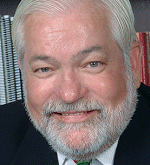
IN CHARGE Laboy led the effort
to upgrade his district’s network.
The project began back in 2001, when district officials set out to replace the iLoop cable that served as the backbone network. The cable was unstable and experienced frequent service disruptions that made instructional and administrative resources inaccessible.
Led by Superintendent Wilfredo T. Laboy, the district set out to find a better way, settling on a wide area network. The first two years involved extensive planning and negotiation. In 2003, the district got moving on the project. The WAN was completed the next year, when all school district buildings were connected. The entire project was paid for with federal E-Rate funds.
Today, with the fiber-based WAN, most of the district’s applications and data reside on large enterprise servers at the central office. Teachers and administrators can access these applications anywhere via a secure IP address. Users can also log on from home through a virtual private network.
Programs on the network include client-hosted Plato Learning courseware, Scholastic’s Read 180, Discovery Education’s United Streaming, and the Waterford Early Reading Program. Administrative tools include the Northwest Evaluation Association’s Measure of Academic Progress scores, Massachusetts Comprehensive Assessment System scores, and IBM’s Lotus Notes.
Looking to the future, Laboy says the district will continue to expand the network, taking full advantage of its newfound reliability. In the long run, this not only will benefit teachers and those who utilize the network, but also students, who will gain from educators’ greater access to data that addresses their needs.
:: SPREAD THE WORDS
Innovator: Larry Ferlazzo, Luther Burbank High School (CA)
Breakthrough: Family literacy
At Luther Burbank High School in Sacramento, CA, educators have turned to technology to help ESL students develop their English and spread it to their families by reading together. The program, dubbed the Family Literacy Project, was the brainchild of teacher Larry Ferlazzo, and has enabled many of the school’s Hmong immigrants to get free computers and DSL service in their homes.
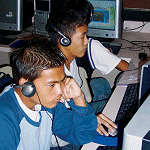
LAB WORK Ferlazzo’s ESL students
have profoundly improved their English
literacy through use of the computer lab
before, during, and after school.
Like most good technology programs, Burbank High’s began in a computer lab. In January 2005, Ferlazzo convinced school administrators to open the lab before and after school so his class of 21 ESL students could practice their English. Ferlazzo put together a website for his students, where they could access a variety of free, animated stories on the internet. The stories were designed to boost literacy. The ESL students loved them; the program took off.
After an upgrade to the lab refreshed the computers, Ferlazzo paved the way for the school to give the old machines to his ESL students to use for further practice at home. With the machines disbursed, the school then ironed out deals with a variety of local internet service providers to provide connectivity. Ferlazzo even convinced the ISPs to provide the school with one central monthly bill, as opposed to billing each individual family, which the school paid via a grant from a private foundation.
Ferlazzo says that assessments taken before and after the launch of the program showed that students and parents in the program had nearly double the improvement in their English reading ability compared to a control group. After seeing the data, the district agreed to fund an expansion of the project to about 60 new families in 2007, to include Spanish speakers and Pacific Islanders as well as more Hmong newcomers. Ferlazzo says the district simply did the math: “A 33 percent gain each for four or five students per family for a cost of $22 per family per month for the DSL service seemed like a pretty good payoff.”
In addition to expanding the Family Literacy Project, the school plans to continue the popular ESL computer lab, which has shown equally dramatic benefits: Students enrolled in the lab class have likewise experienced 50 percent greater improvement in their reading scores than those in a control group.
What’s more, Ferlazzo’s students have begun to create their own English-learning activities, which are being posted on the website for other users to access. With computers at school and at home, Ferlazzo’s students and their families have spoken repeatedly about how the reading, speaking, listening, and writing exercises have helped them improve their English and have boosted their confidence in speaking the language.
Ferlazzo says that whether by getting Hmong and Spanishspeaking students together in the computer lab or by having entire families read the same “talking book” together, the aim is to use computers as an instrument to increase face-to-face human engagement, and to give students and their families a wide range of activities to choose from to improve their English. He concludes, “We have given them just that.”
:: BEYOND BOUNDARIES
Innovators: Craig Paulson and Jason Kopp, Cambridge-Isanti High School (MN)
Breakthrough: Distance learning
Getting on board the internet2 movement has allowed Cambridge-Isanti High School in Minnesota to extend its education globally, regularly inserting its educators and students in discussions,virtual field trips, and case studies around the world.
“IP [internet protocol] video is quickly becoming an exciting new vehicle for distance learning,” says CIHS former Principal Craig Paulson, who left the school at the end of 2005-2006 to become the director of the doctorate program in educational administration at Bethel University, about an hour’s drive from CIHS. “The implication of the world becoming ‘flat’ is that interactions among educators around the world are becoming increasingly important. Educators are finding that their colleagues and students are international rather than just local.”
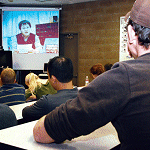
NO LIMITS Via IP video,
CIHS students engage in
activities around the world.
CIHS had previously used two-way interactive cable television and other two-way communication processes to create educational opportunities within its region, but a forward-thinking group of administrators set out to extend those learning experiences worldwide through the implementation of internet2 and IP video. The high school’s regional cable consortium, East Central Minnesota Cable Consortium, equipped CIHS with a Polycom ViewStation FX for its initial connections. But the school soon found its network infrastructure was inadequate for ongoing connections, which led to a full-scale upgrade of its backbone with new Cisco switches and a shared 100- megabyte connection to the internet. Since then, CIHS has purchased several Polycom videoconferencing cameras and has made IP videoconferencing over internet2 a regular part of many of its courses, extending the partnerships of CIHS globally.
“The use of IP video to expand a network of global partners takes a team of leaders,” Paulson says, “especially a technician and a facilitator.” He credits CIHS Technology Coordinator Jason Kopp for filling those roles. From his new post at Bethel, Paulson has worked with Kopp to continue creating IP partnerships for CIHS. One example of a cooperative, global educational experience developed by the two institutions brought Bethel science education majors together with science teachers at CIHS and Taikyu High School, CIHS’s sister school in Wakayama, Japan, to discuss current science-teaching practices. CIHS and Taikyu students also meet regularly via internet2 to discuss world events and how they relate to their respective country and culture. Additionally, Kopp facilitated a partnership between CIHS and Mary Mei, a high school teacher in Taiwan, which consequently linked Mei’s school with Bethel University.
These kinds of partnerships have created extraordinary educational opportunities for CIHS students. They observed a live open-heart surgery in Rhode Island and were able to ask the surgeon questions before, during, and after the operation.
CIHS personnel worked with the Minnesota National Guard to set up a live discussion with local troops in Afghanistan, as well as a dialogue between students enrolled in the school’s World Affairs course and an Afghan-Canadian national and his family in Kurat, Afghanistan. Meanwhile, CIHS teachers have used videoconferencing to “travel” to such places as the Buffalo Zoo in New York and the Oceanic Institute in San Diego, CA. They even linked up with Norvik, a remote village in Alaska, to discuss environmental impacts on its geography.
“Each connection in which we participate with others around the world creates a positive impact on our students’ learning,” says Paulson. “The only things necessary to create these global connections are creativity and a willingness to extend the classroom outside the traditional walls of the school building.”